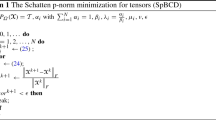Abstract
In this work, we consider the tensor completion problem of an incomplete and noisy observation. We introduce a novel completion model using bilevel minimization. Therefore, bilevel model-based denoising for the tensor completion problem is proposed. The denoising and completion tasks are fully separated. The upper-level directly addresses the completion problem with the truncated nuclear norm, while the lower-level uses the sparsity prior which is characterized by the l1-norm for the denoising task. Furthermore, we propose a simple strategy to solve our bilevel optimization problem. It formulates the lower-level as a fixed-point equation and then applies a simple but efficient iterative algorithm to get the reconstructed tensor. Numerically, the superiority of the proposal is reported via several experiments conducted on real data with an extremely small subset of observed entries.
Similar content being viewed by others
References
Candes, E.J., Recht, B.: Exact matrix completion via convex optimization. Foundations of Computational Mathematics 9(6), 717 (2009)
Lin, Z., Ganesh, A., Wright, J., Wu, L., Chen, M., Ma, Y.: Fast convex optimization algorithms for exact recovery of a corrupted low-rank matrix. UIUC Technical Report UILU-ENG-09-2214 (2009)
Banouar, O., Mohaoui, S., Raghay, S.: Collaborating filtering using unsupervised learning for image reconstruction from missing data. EURASIP Journal on Advances in Signal Processing 2018(1), 72 (2018)
Natterer, F., Wübbeling, F.: Mathematical Methods in Image Reconstruction, vol. 5. SIAM, Philadelphia (2001)
Unser, M., Chenouard, N.: A unifying parametric framework for 2D steerable wavelet transforms. SIAM J. Imag. Sci. 6(1), 102–135 (2013)
Ochs, P., Ranftl, R., Brox, T., Pock, T.: Bilevel optimization with nonsmooth lower-level problems. In: International Conference on Scale Space and Variational Methods in Computer Vision, pp 654–665. Springer, Cham (2015)
Kunisch, K., Pock, T.: A bilevel optimization approach for parameter learning in variational models. SIAM Journal on Imaging Sciences 6(2), 938–983 (2013)
Lu, C., Feng, J., Chen, Y., Liu, W., Lin, Z., Yan, S.: Tensor robust principal component analysis: exact recovery of corrupted low-rank tensors via convex optimization. In: Proceedings of the IEEE conference on computer vision and pattern recognition, pp 5249–5257 (2016)
Xue, S., Qiu, W., Liu, F., Jin, X.: Low-rank tensor completion by truncated nuclear norm regularization. In: 2018 24th International Conference on Pattern Recognition (ICPR), pp 2600–2605. IEEE (2018)
Ye, J.J., Ye, X.Y.: Necessary optimality conditions for optimization problems with variational inequality constraints. Math. Oper. Res. 22(4), 977–997 (1997)
Dempe, S., Gadhi, N.: Necessary optimality conditions for bilevel set optimization problems. J. Glob. Optim. 39(4), 529–542 (2007)
Bard, J.F., Falk, J.E.: An explicit solution to the multi-level programming problem. Computers Operations Research 9(1), 77–100 (1982)
Ye, J.J.: Constraint qualifications and KKT conditions for bilevel programming problems. Math. Oper. Res. 31(4), 811–824 (2006)
Chen, G.H., Rockafellar, R.T.: Convergence rates in forward–backward splitting. SIAM J. Optim. 7(2), 421–444 (1997)
Ma, S., Goldfarb, D., Chen, L.: Fixed-point and Bregman iterative methods for matrix rank minimization. Mathematical Programming 128(1-2), 321–353 (2011)
Zhang, D., Hu, Y., Ye, J., Li, X., He, X.: Matrix completion by truncated nuclear norm regularization. In: 2012 IEEE Conference on Computer Vision and Pattern Recognition, pp 2192–2199. Providence (2012)
Hu, Y., Zhang, D., Ye, J., Li, X., He, X.: Fast and accurate matrix completion via truncated nuclear norm regularization. In: IEEE Transactions on Pattern Analysis and Machine Intelligence, vol. 35, pp 2117–2130 (2013)
Hintermuller, M., Wu, T: Bilevel optimization for calibrating point spread functions in blind deconvolution (2015)
Song, Y., Li, J., Chen, X., Zhang, D., Tang, Q., Yang, K.: An efficient tensor completion method via truncated nuclear norm. J. Vis. Commun. Image Represent., 102791 (2020)
Rojo, O., Rojo, H.: Some results on symmetric circulant matrices and on symmetric centrosymmetric matrices. Linear Algebra and its Applications 392, 211–233 (2004)
Liu, Q., Lai, Z., Zhou, Z., Kuang, F., Jin, Z.: A truncated nuclear norm regularization method based on weighted residual error for matrix completion. IEEE Trans. Image Process. 25(1), 316–330 (2015)
Yokota, T., Hontani, H.: Simultaneous visual data completion and denoising based on tensor rank and total variation minimization and its primal-dual splitting algorithm. In: Proceedings of the IEEE Conference on Computer Vision and Pattern Recognition, pp 3732–3740 (2017)
Yokota, T., Hontani, H.: Simultaneous tensor completion and denoising by noise inequality constrained convex optimization. IEEE Access 7, 15669–15682 (2019)
Xu, R.H., Yin, W., Su, Z.: Parallel matrix factorization for low-rank tensor completion. Inverse Problems & Imaging 9 (2), 601–624 (2015). https://doi.org/10.3934/ipi.2015.9.601
Author information
Authors and Affiliations
Corresponding author
Additional information
Communicated by: Raymond H. Chan
Publisher’s note
Springer Nature remains neutral with regard to jurisdictional claims in published maps and institutional affiliations.
Rights and permissions
About this article
Cite this article
Mohaoui, S., Hakim, A. & Raghay, S. Tensor completion via bilevel minimization with fixed-point constraint to estimate missing elements in noisy data. Adv Comput Math 47, 10 (2021). https://doi.org/10.1007/s10444-020-09841-8
Received:
Accepted:
Published:
DOI: https://doi.org/10.1007/s10444-020-09841-8




